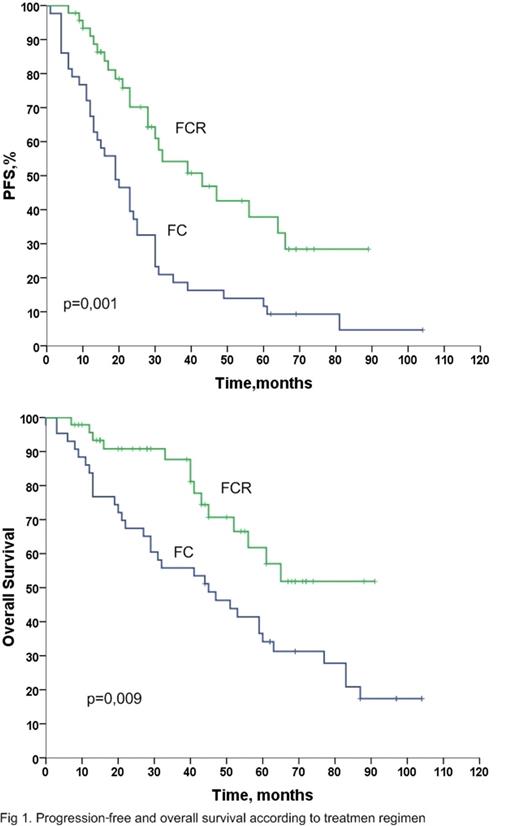Abstract
Abstract 4616
Fludarabine-containing regimens are widely used as the first-line treatment for CLL. In recent phase III trial (CLL8) significantly superior results in terms of response rates, PFS and OS were shown in FCR arm compared to FC. FCR regimen has thus become standard for initial CLL treatment. However CLL8 trial included patients with relatively low CIRS (median 1). Our retrospective study shows application of this regimen to everyday practice without special selection of patients according to CIRS.
To estimate survival benefit produced by the addition of rituximab to standard FC regimen for treatment-naïve not selected CLL pts and measure the influence of CIRS on OS and PFS.
90 consecutive pts were included (43 in FC and 47 in FCR arm) between 2002 and 2010 according to intent-to-treat. Informed consent was obtained in each case. Assignment to FCR was based predominantly on the availability of rituximab and starting from 2007 all pts received it as part of treatment. All patients were personally supervised by one of us (E.S.) and there were no losses at follow-ups. Arms were well balanced with regard to sex (M-to-F ratio ∼2:1), age (median 59 years, range 43–78) and disease stage. CIRS score for each patient was measured retrospectively based on available medical records. Median comorbidity index was 4 (range 0–10) for the whole cohort and it was the same for both FC and FCR subgroups, however max CIRS was 10 for FC and 8 for FCR. Both treatment arms were well-balanced for patients with CIRS score >6 (17/40% in FC arm and 22/45% in FCR arm).
All CLL patients with standard indications for start of the treatment according to IWCLL criteria were included except those with acute infections, severe dysfunction of liver, heart or kidneys (grade 4 in CIRS), psychiatric disorders, active hemolytic anemia or active hepatitis B infection.
Pts were divided into 2 groups according to CIRS: those with low (lCI, CIRS≤6) and high comorbidity index (hCI, CIRS>6).
Treatment schedules were standard. Response was assessed according to IWCLL criteria (in patients included before 2008 this type of response was assessed retrospectively). Only 11 pts received less than 6 cycles (range 4–5). Statistical analysis was done with SPSS17.
OR and CR rates in FCR and FC groups were 94% vs 81% (p=0,15) and 70% vs 46% (p=0,045) respectively. PR rates were 24% for FCR and 35% for FC (p=0,2).
47 patients died during follow-up: 10 (21%) due to disease progression (incl. 2 Richter’s transformations), 7 (15%) – secondary malignancies, 30 (64%) – infections. 33 deaths were registered in FC arm (77%) and 14 in FCR (32%), p=0,001. After 9 years of follow-up, median OS in FCR arm was not achieved and was 45 mos in FC arm (p=0,009). Median PFS in FCR arm was 43 mos compared to 19 mos in FC arm (p=0,001) - Fig1. There were 40 events in FC (93%) and 25 in FCR arm (53%).
According to CIRS, 39 and 51 pts had respectively high and low comorbidity index. Pts with hCI and lCI differed in their age (medians respectively 64,5 and 55 years). This difference was statistically significant (p=0,001).
CIRS didn’t influence significantly the survival in the whole group of patients: median PFS was 37 and 50 mos in hCI and lCI patients (p=0,28) respectively. Median OS was 53 and 60 mos, respectively (p=0,7).
In FCR group median PFS was 40 mos in hCI pts and 64 mos in lCI pts (p=0,3), medians of OS were 79 and 79 mos respectively (p=0,9).
In FC group, median PFS was 20 mos in hCI pts and 19 mos in lCI (p=0,4), medians of OS were 45 and 44 mos respectively (p=0,5) - Fig 2.
FCR was advantageous over FC in both CI groups. In lCI group, median PFS was 20 mos in FC pts and 60 mos in FCR pts, p=0,01, medians OS 44 mos and not achieved, p=0,005 respectively.
In hCI median, PFS was 20 mos in FC and 40 mos in FCR, p=0,01 and median OS 45 and not achieved, p=0,02 respectively.
Conclusions
Addition of rituximab to FC regimen in first line improves long-term OS and PFS. Comorbidity measured by CIRS seems not to influence PFS and OS in our cohort. Even in patients with high CIRS score (without severe organ dysfunction) FCR is well tolerated and provides survival advantage over FC regimen.
No relevant conflicts of interest to declare.
Author notes
Asterisk with author names denotes non-ASH members.



This feature is available to Subscribers Only
Sign In or Create an Account Close Modal